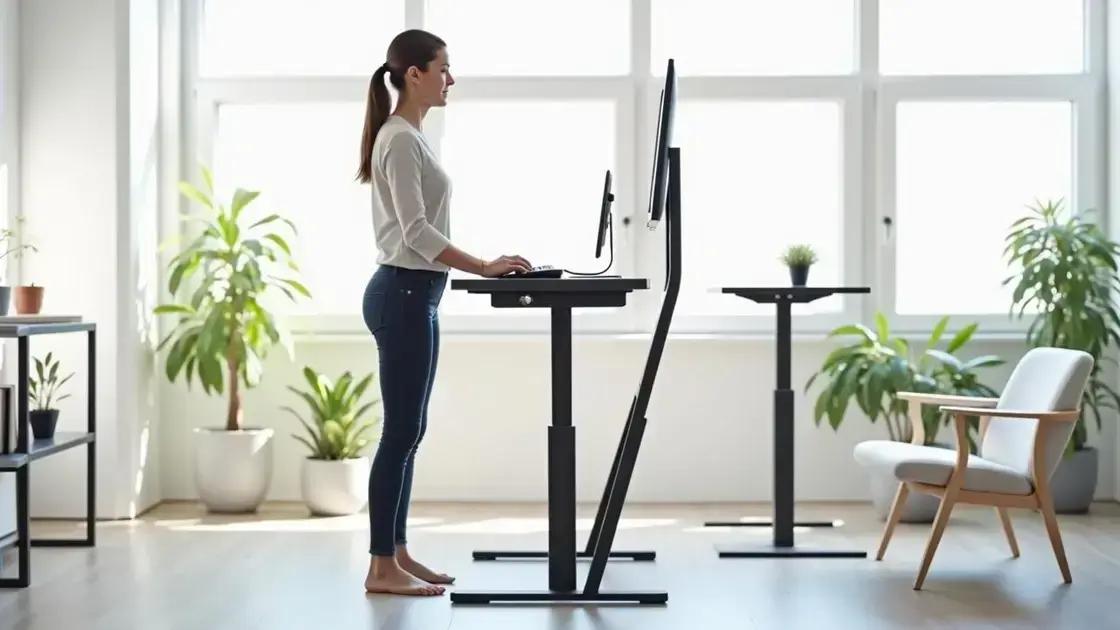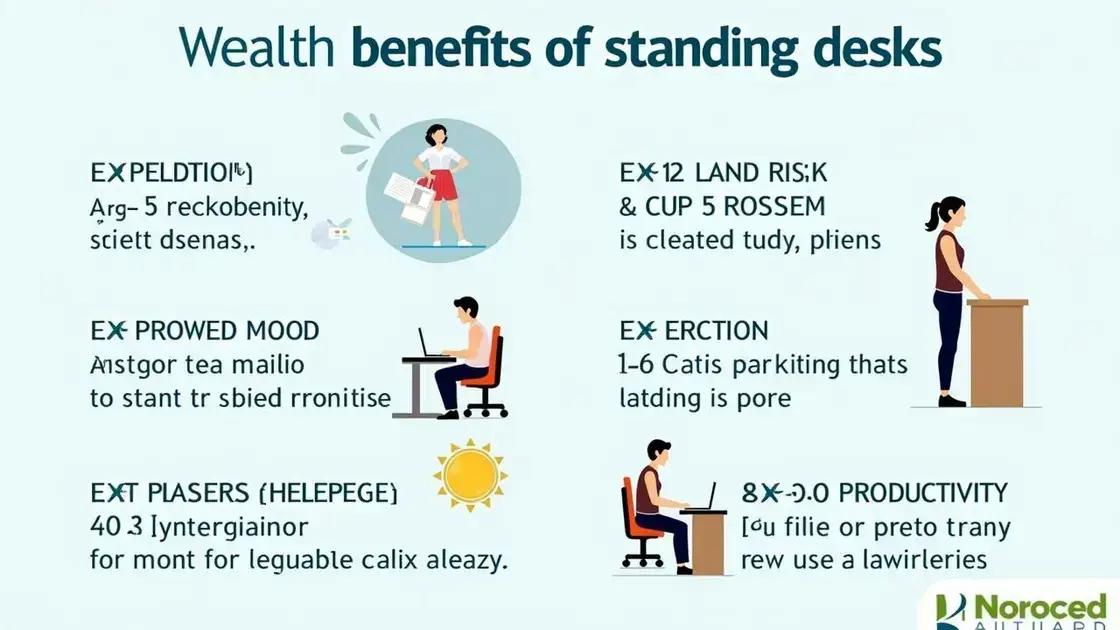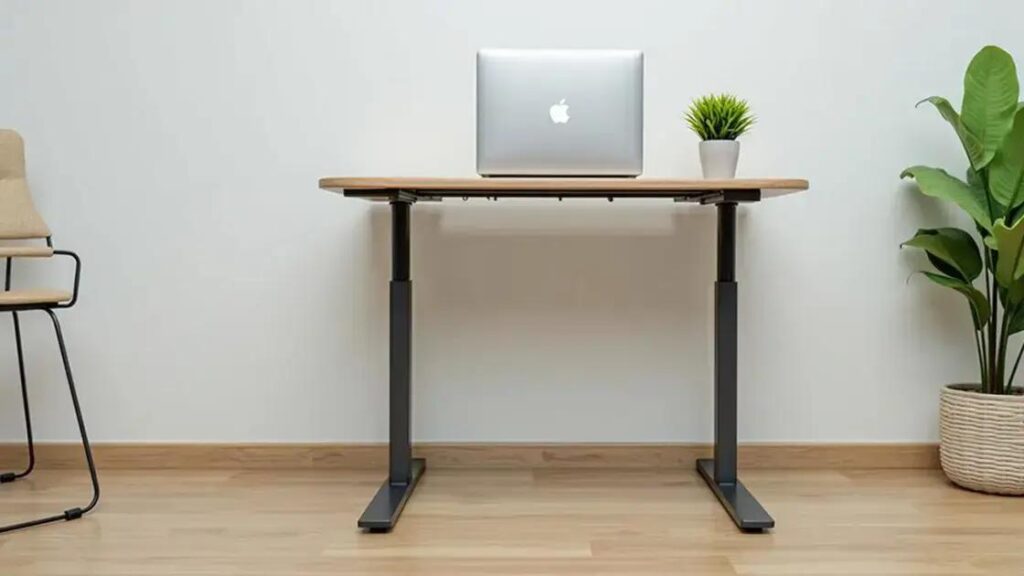The benefits of using a standing desk for improved posture include promoting better spinal alignment, reducing back pain, increasing energy levels, and enhancing overall productivity. Transitioning gradually, adjusting desk height, and incorporating regular movement can help maximize the health advantages of standing desks.
The benefits of using a standing desk for improved posture are becoming increasingly clear as more people seek healthy work environments. Standing desks help to maintain a natural spine alignment, reducing the common problems associated with prolonged sitting, such as back pain and fatigue. In this article, we will explore the significance of posture, how standing desks can enhance your sitting habits, the health advantages associated with standing while you work, and practical tips to smoothly transition to this new workspace setup.
Understanding Posture and Its Importance

Posture refers to the way we hold our bodies when sitting, standing, or moving. It is essential for our overall health and well-being. Good posture keeps our bones and joints in correct alignment. This helps to prevent fatigue because our muscles are used effectively. When we have good posture, we avoid putting extra strain on ligaments, which means less pain and discomfort.
Importance of Maintaining Good Posture
Maintaining good posture is crucial in our daily lives. It not only affects our physical health but can also influence our mental state. Good posture can improve our breathing, allowing us to take deeper breaths and supply better oxygen to our body. Moreover, good posture can enhance our mood and boost our confidence, making us feel more positive and ready to tackle our daily tasks.
Common Posture Problems
Many people struggle with poor posture, especially those who sit for long periods. Common issues include slouching or leaning forward. These habits can lead to discomfort and even long-term health problems such as neck and back pain. Recognizing these issues is the first step toward improvement.
How Standing Desks Help
Using a standing desk can play a significant role in correcting poor posture. By allowing us to stand rather than sit, these desks encourage a more natural alignment of the spine. Standing while working serves as a reminder to maintain a healthier posture, preventing the slumping that often occurs while sitting.
How Standing Desks Improve Posture

Standing desks are an excellent tool for improving posture in various ways. When you transition from sitting to standing, your body is encouraged to align more naturally. This alignment is important for your spine and overall body mechanics. Good posture while standing helps to distribute your weight evenly, reducing strain on specific muscles and joints.
Encourages Proper Spine Alignment
One of the primary ways standing desks improve posture is by promoting proper spine alignment. When standing, your back can curve naturally without the pressure that sitting often brings. This can lead to a decrease in discomfort and pain in the lower back region.
Enhances Core Strength
Using a standing desk engages your core muscles. As you stand, your body naturally tries to balance itself, leading to stronger abdominal and lower back muscles over time. This development of core strength supports good posture by providing a stable foundation for your spine.
Reduces the Risks of Slouching
Standing desks help counteract the habit of slouching that often occurs when sitting for long periods. With a standing desk, it becomes easier to maintain an upright position, which can reduce the tendency to slump and promotes an open chest and relaxed shoulders.
Promotes Movement Throughout the Day
Another benefit of standing desks is that they encourage more movement during the workday. When you stand, it’s instinctual to shift your weight or take small steps. This movement not only helps with blood circulation but also decreases the chance of stiffness that leads to poor posture.
Health Benefits of Standing Desks

The health benefits of standing desks are significant and have gained attention in recent years. Many studies reveal that moving away from traditional sitting can lead to improvements in overall health. When using a standing desk, people often experience better vitality and less fatigue than those who sit all day.
Reduces Risk of Weight Gain and Obesity
Switching to a standing desk can also help reduce the risk of weight gain and obesity. Standing burns more calories compared to sitting. Even small changes can add up. By standing while working, you can help maintain a healthier weight.
Decreases the Risk of Chronic Diseases
Extended periods of sitting are linked to chronic diseases such as heart disease and diabetes. Standing desks may help lower the risk of these diseases. By encouraging more movement and reducing sedentary time, standing desks can potentially lead to longer, healthier lives.
Improves Mood and Energy Levels
Using a standing desk has been shown to improve mood and keep energy levels higher. People who stand at their desks often report feeling more energized and less stressed throughout the day. This positive effect can help enhance productivity and overall job satisfaction.
Enhances Focus and Productivity
Standing while you work can also enhance focus and productivity. When you stand, it may be easier to keep your mind alert and engaged. Many users find that they are more productive and can handle tasks more efficiently while standing compared to sitting.
Tips for Transitioning to a Standing Desk

Transitioning to a standing desk can be exciting yet challenging. Here are some helpful tips to make the switch smoother and more comfortable.
Start Gradually
Don’t feel like you need to stand all day right away. Start with short periods of standing, such as 15 to 30 minutes, then take sitting breaks. Gradually increase the time you spend standing as your body adjusts.
Adjust Your Desk Height
Ensure your standing desk is at the right height for comfort. Your elbows should be at a 90-degree angle when typing. The top of the monitor should be eye level to avoid straining your neck.
Wear Comfortable Shoes
Supportive footwear is essential when using a standing desk. Avoid high heels or flip-flops. Instead, choose shoes that offer good support to help reduce discomfort while standing.
Try an Anti-Fatigue Mat
An anti-fatigue mat can be a great addition to your standing desk. These mats provide cushioning and support, helping to reduce fatigue and discomfort in your feet and legs as you stand for longer periods.
Incorporate Movement
Remember to move around! Shift your weight from one leg to another, stretch, or walk around during your breaks. This will help prevent stiffness and keep your blood circulating.
Listen to Your Body
Pay attention to how your body feels. If you start to feel discomfort, sit down for a while or take a break. It’s essential to find a balance that feels right for you.
Embracing the Benefits of Standing Desks
Transitioning to a standing desk offers numerous advantages, including improved posture, enhanced health benefits, and increased productivity. By gradually adapting to a standing work style, adjusting your workspace, and prioritizing comfort, you can create a more engaging and healthier work environment.
As you explore the numerous benefits, remember to incorporate regular movement and listen to your body. Standing desks are not just about standing; they are about finding an effective balance between sitting and standing for optimal health.
Incorporating these changes can lead to a more vibrant work experience that boosts both morale and efficiency. So take the leap today and enjoy the many benefits that a standing desk can bring to your daily routine.
FAQ – Frequently Asked Questions About Standing Desks
What are the main benefits of using a standing desk?
Standing desks help improve posture, reduce the risk of chronic diseases, increase energy levels, and enhance overall productivity.
How should I transition to a standing desk?
Start gradually by alternating between sitting and standing. Adjust your desk height and take regular breaks to move around.
Can standing desks help with back pain?
Yes, standing desks can promote better spinal alignment, reduce pressure on the lower back, and decrease discomfort that often comes from prolonged sitting.
What items should I consider for comfort while using a standing desk?
Consider wearing supportive shoes and using an anti-fatigue mat to enhance comfort when standing for extended periods.
Is it necessary to stand all day at a standing desk?
No, it’s not necessary to stand all day. It’s important to find a balance that works for you, including sitting breaks and movement.
How can I maintain my energy levels while using a standing desk?
Incorporate regular movement and stretches to keep your blood flowing and energy levels high throughout the day.












